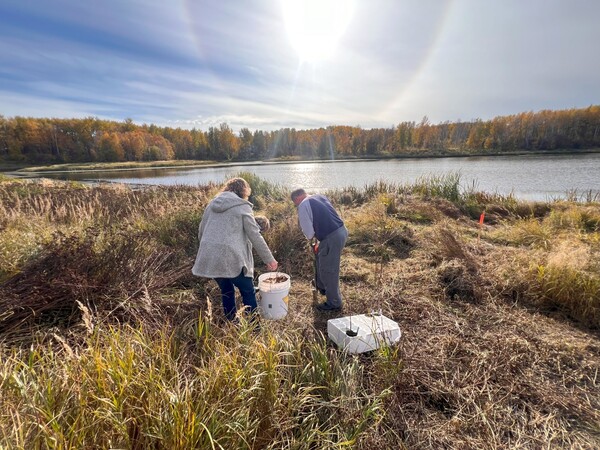Rooted in Sustainability: How the Green Acreages Program is Helping to Transform Rural Properties

Since its inception, the Green Acreages Program (GAP) has played a foundational role in growing greener and more sustainable futures. By offering tailored resources on effective land management practices, organizing workshops, providing direct consultation and cost-share funding opportunities through the Government of Alberta’s Watershed Resiliency and Restoration Program (WRRP), the program empowers land and property owners to implement practical stewardship efforts on rural lands. Here’s one example of how the Green Acreages is helping people to better manage and transform their properties.
The most recent GAP workshop, hosted by Parkland County in October 2024, was a tremendous success, with full registration, a waiting list and complete attendance by all 20 registered participants.
Coordinated and funded by Parkland County, the workshop involved two parts, combining classroom learning with hands-on activity. First, participants attended an in-hall session where Milena McWatt, the Green Acreages program coordinator, gave a presentation on GAP, highlighting program resources like the Green Acreages Guide Workbook, helping people understand how to use the workbook to guide efforts to enhance their properties, as well as the project funding available to help them implement stewardship projects. During the workshop, and with the aid of an aerial map of their properties, participants had the opportunity to brainstorm potential stewardship initiatives for their acreages.
The workshop was followed by a visit to nearby Sauer Lake in Parkland County for an on-site demonstration led by local wetland ecologist Kristen Andersen from Associated Environmental. With funding support from WRRP, Parkland County gave participants the opportunity to plant native species at the site in areas that were previously overrun by tansy, replacing the invasive plant with balsam poplar, trembling aspen and willows to strengthen the bank’s root network, reduce erosion and flood risks, and shade out invasive species.
"There is only so much that municipalities can do on their own county lands," explains Stephanie Over, Parkland County’s Natural Asset Project Coordinator. "We also rely on residents to implement sustainable practices on their properties, which is why demonstrating what is feasible to property owners in the area is so important."
This sentiment is resonating with property owners.
Workshop participant and acreage owner Natalie Bak expressed appreciation for the information and learning opportunities provided at the workshop, emphasizing that the chance to feel part of a community while actively taking care of it was both invaluable and rewarding.
"Any opportunity we can get to learn is a wonderful and valuable one; you can never know too much," says Natalie, who attended the workshop to learn more about the kind of projects she could implement on her acreage without causing harm to the environment.
In 2025, Milena anticipates seeing more of this hybrid model of Green Acreages workshops taking place across the province.
The success of the Parkland County workshop is just one example of the meaningful impact the program has had on rural communities. Between April and November last year, a total of 280.83 acres were influenced by stewardship projects funded projects through the program. Projects ranged from riparian and upland planting with native species, to installing exclusion fencing, and planting shrubs and native trees for snow capture and drought resiliency, to name a few. During that period, 109 acreage owners attended seven in-person Green Acreages workshops, over 105 workbooks were distributed to property owners and a total of $26,986.50 of funding was reimbursed to landowners for cost-share stewardship projects.
These statistics alone highlight the critical role that Green Acreages and partner municipalities play in providing education, resources and support for landowners who are eager to implement stewardship practices on their properties. With over 567,000 acres of rural residential land in Alberta, this program provides vital resources to a growing group of underserved landowners, empowering them to make changes that can contribute to increasing resilience to the effects of climate change and lessening the impacts of drought and flooding through their land management practices.
In that spirit of stewardship, the program coordinator looks forward to more years of working closely with municipalities and property owners to enhance natural watershed function and protect nature’s valuable assets in rural areas and beyond.
"With the knowledge from last winter's inventory of acreages in Alberta that there are over 100,000 such properties in our province, plus the momentum that has been building with the Green Acreages Program, there is such great potential for positive cumulative effects on ecosystems and associated ecosystem services," says Milena.
"It's very exciting to get requests from all over the province and meet so many folks who are committed to learning about and taking action on land stewardship," she adds.
If you are an acreage, hobby farm or recreational property owner, watch for a Green Acreages workshop in your community or reach out to the program coordinator to discuss a potential stewardship project.


Leave a comment